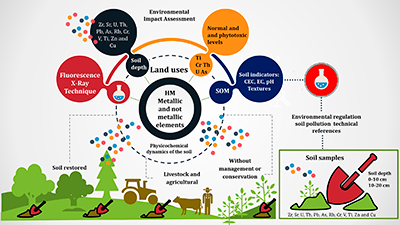Indicators of restoration strategies in land uses: metallic and non-metallic elements
DOI:
https://doi.org/10.48162/rev.39.095Palabras clave:
materia orgánica del suelo, profundidad del suelo, uso de suelo, fitotóxicoResumen

Land management practices can have an impact on the environmental quality of soil and contribute to identifying the source of its pollution. The objective of this study was to determine presence of metallic and non-metallic elements as indicators of land use impact (livestock management, restoration strategies and without management practices) in the Monte Caldera communal lands located in Cerro de San Pedro, San Luis Potosi, Mexico. Eighteen samples were collected at depths of 0-10 cm and 10-20 cm for each land use. Total concentrations of Zr, Sr, U, Th, Pb, As, Rb, Cr, V, Ti, Zn, and Cu were determined by X-ray fluorescence. Mean concentrations ranged in the following order: Ti>Zr>Rb>V>Sr>Zn>Cr>Pb> Cu>Th>U>As, with concentrations for Ti, Cr, Th, U and As exceeding technical reference values for phytotoxic soils. Significant differences were evidenced by ANOVA between land use (Th, Pb, Rb, Cu) and soil depth (U, Pb, and As). Land use practices associated with restoration resulted in a positive environmental impact. These findings underscore the need to conduct follow-up studies in the area and further examine the relationship of such practices with other environmental factors.
Highlights:
- Soil management practices can affect the environmental quality of this resource and help diagnose the source of its contamination.
- It is necessary to evaluate the Impact of land use on livestock management, restoration strategies, and without management or conservation areas.
- By X-ray fluorescence technique the total concentration of Zr, Sr, U, Th, Pb, As, Rb, Cr, V, Ti, Zn, and Cu was determined.
- Ti, Cr, Th, U and As exceed the technical reference values for consideration as phytotoxic in soils.
- Land use associated with reclamation practices is an indicator of a positive influence on improving soil quality.
Descargas

Descargas
Publicado
Cómo citar
Número
Sección
Licencia
Derechos de autor 2018 Revista de la Facultad de Ciencias Agrarias UNCuyo

Esta obra está bajo una licencia internacional Creative Commons Reconocimiento-NoComercial-CompartirIgual 3.0.
Aquellos autores/as que tengan publicaciones con esta revista, aceptan las Políticas Editoriales.










.jpg)




